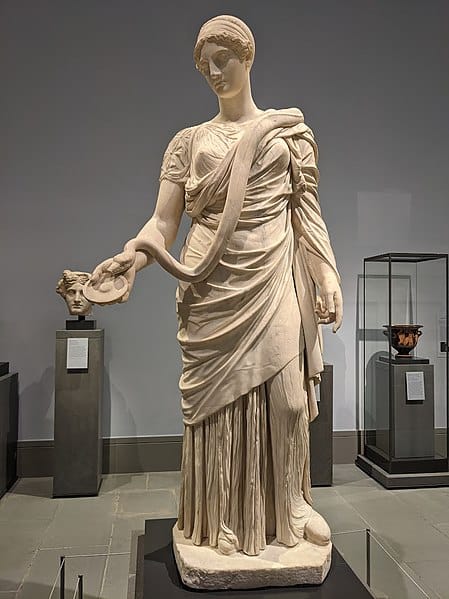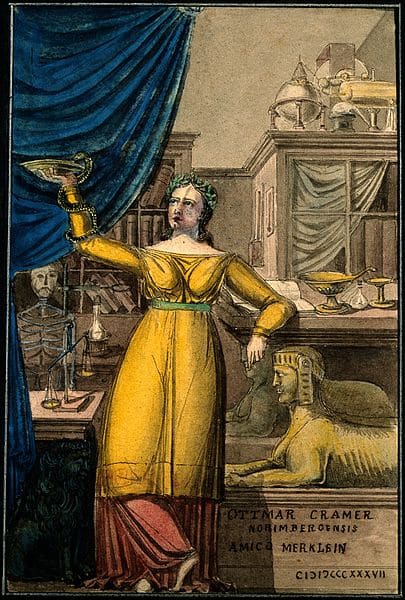In the intricate web of Greek mythology, where gods and goddesses oversee various aspects of life and the universe, Hygieia stands as a symbol of health and cleanliness. As the daughter of Asclepius, the god of medicine, she plays a crucial role in the well-being of both gods and mortals.
Hygieia Key Facts
| Parents | Asclepius and Epione |
| Partners | None |
| Siblings | Panacea, Aceso, Iaso, and others |
| Offspring | None |
| Other names | Salus (Roman name) |
| Roman name | Salus |
| The Goddess of | Health and Cleanliness |
| Symbols | Serpent, Cup, and Laurel Wreath |
Name and Etymology
The name “Hygieia” is derived from the Greek word “Hygieia,” which translates to “health” or “hygiene.” In Roman mythology, she is known as Salus, a name that also emphasizes well-being and safety. Various epithets and alternative names for Hygieia focus on her role as a protector against disease and a promoter of good health.
In Roman culture, Salus holds a similar but distinct role. While both goddesses are concerned with health, Salus is more closely associated with public welfare and the prosperity of the Roman state. It’s important to distinguish between the two, as they are separate entities with their own sets of myths and attributes.
The name Hygieia has had a lasting impact, even influencing modern language. The term “hygiene” is directly derived from her name, emphasizing her lasting influence on the concept of health and cleanliness.

Hygieia’s Origins
Born to Asclepius, the god of medicine, and Epione, the goddess of soothing pain, Hygieia was destined for a life focused on health and well-being. She has several siblings, including Panacea, the goddess of universal remedy, and Iaso, the goddess of recuperation, among others. This divine family dedicated themselves to various aspects of health and medicine, each complementing the other.
While there’s no specific account detailing Hygieia’s birth or childhood, her upbringing likely revolved around her father’s famous healing temple, the Asclepeion. Here, she would have been immersed in the world of ancient medicine, learning the arts of healing and cleanliness.
As a Daemone, or spirit, Hygieia personifies the concept of health. Her role is not just about physical well-being but also encompasses mental and environmental health. She stands as a constant reminder of the balance needed to maintain a healthy life, both for individuals and communities.
Hygieia’s Lovers and Relationships
Platonic Relationships
Hygieia is unique among Greek goddesses in that she doesn’t have romantic relationships detailed in myths. Instead, her relationships are often platonic, focused on her role in health and wellness. She is frequently seen alongside her father, Asclepius, and her siblings, working in harmony to promote health and prevent disease.
Her relationship with her father is particularly noteworthy. Asclepius, renowned for his healing abilities, often relied on Hygieia’s expertise in cleanliness and preventive care. Together, they formed a dynamic duo in the realm of ancient medicine, complementing each other’s skills and knowledge.
Depiction And Characteristics
Hygieia is often portrayed as a serene and focused woman, embodying the virtues of cleanliness and health.
In art and sculptures, Hygieia is usually depicted as a mature woman holding a serpent in one hand and a bowl or cup in the other. The serpent, a symbol of rejuvenation, is often shown drinking from the cup, symbolizing the interconnectedness of health and the natural world. She is also frequently adorned with a laurel wreath, a symbol of victory and protection.
Personality and Powers
Hygieia’s personality is often described as calm, nurturing, and focused. Unlike some of the more tempestuous gods and goddesses, she embodies stability and balance. Her demeanor reflects her role in maintaining health and preventing illness. The ancient Greeks saw her as a guardian of physical and mental well-being, a deity to be invoked for protection against disease and ill health.
As the goddess of health and cleanliness, Hygieia had the unique ability to protect against diseases. She was also believed to have preventive powers, helping to maintain the balance of health in both individuals and communities. Her role was not just reactive, curing ailments, but also proactive, promoting a lifestyle that prevented illness in the first place.
Hygieia’s Symbols
Hygieia is closely associated with the serpent, a creature symbolizing rejuvenation and healing. The serpent drinking from a cup or bowl is a common motif in depictions of Hygieia and serves as her primary symbol. This image encapsulates her role in health, emphasizing the importance of balance and natural harmony.
The laurel wreath is another symbol often associated with Hygieia. Traditionally a symbol of victory, in the context of Hygieia, it represents the “victory” over illness and the maintenance of good health. The laurel wreath also has connections to Apollo, her grandfather, further linking her to the divine aspects of medicine and healing.
Hygieia’s Roles And Responsibilities
Hygieia’s primary role was to maintain and promote health. This responsibility extended beyond mere physical well-being to include mental and environmental health. She was the go-to deity for anything related to preventive care, cleanliness, and general well-being.
In addition to her preventive role, Hygieia was also invoked for protection against diseases and epidemics. During times of plague or widespread illness, offerings would be made to her in the hope that she would intervene and halt the spread of disease.
Her responsibilities were not just limited to individual health but extended to community well-being. She was considered a guardian of public health, and her principles were often incorporated into the planning and construction of public spaces, including baths and gymnasiums.
Myths about Hygieia
Hygieia, unlike many other gods and goddesses, doesn’t feature prominently in a wide range of myths. However, her role in the myth of the Plague at Athens is noteworthy. During a devastating plague, the Athenians consulted the Oracle at Delphi, who advised them to seek the aid of Asclepius. Asclepius sent Hygieia and her sister Panacea to Athens, where they were able to halt the spread of the disease.
This myth highlights Hygieia’s preventive and healing powers. It also emphasizes her role in community health, showing that she could intervene on a large scale to stop an epidemic. The story serves as a testament to her importance, not just as a subsidiary figure in her father’s exploits but as a powerful deity in her own right.
Hygieia In Ancient Greek Religion
Hygieia’s role in ancient Greek religion was primarily preventive. She was invoked for protection against diseases and was considered a guardian of both individual and community health.
Sites or Temples Sacred to Hygieia
Temples dedicated to Hygieia were often located near or within the sanctuaries of Asclepius. These temples served as centers for healing and were often equipped with baths. Furthermore promoting cleanliness as a form of preventive care. One of the most famous temples dedicated to Hygieia was located in Epidaurus. Moreover, this was a city renowned for its focus on health and medicine.
In addition to temples, there were also altars and smaller shrines dedicated to Hygieia throughout ancient Greece. These smaller sites were often located in public spaces like gymnasiums and baths, places where health and cleanliness were important.
Worship and Festivals
Hygieia was worshiped through various rituals aimed at promoting health and preventing disease. Offerings of food and incense were common, as were vows and prayers asking for protection against illness. There were no specific festivals dedicated solely to Hygieia. However, she was often honored during festivals related to health and well-being, such as the Asklepieia, a festival dedicated to her father, Asclepius.
Representations Of Hygieia In Art
Hygieia has been depicted in various forms of art, from sculptures to vase paintings. One of the most famous is the statue of Hygieia by the sculptor Scopas. Created in the 4th century BC, this statue captures the goddess in a serene pose, holding a snake and a bowl, her traditional symbols.
Another notable representation is found in the frescoes of the Temple of Epidaurus. There she is shown alongside her father and siblings. These artistic depictions not only highlight her importance. They also give us insights into how she was perceived by the ancient Greeks.
Mentions in Ancient Texts
Hygieia is mentioned in several ancient texts, although not as extensively as some other deities. In Homer’s “Iliad,” she is referred to as one of the daughters of Asclepius, emphasizing her role in health and medicine. Another mention can be found in the works of Pausanias, a 2nd-century AD geographer, who describes the temples and rituals dedicated to her.
“Health, who is honored in the sky with her father Asclepius,” writes the poet Callimachus in one of his hymns. This quote encapsulates the essence of Hygieia, portraying her as a revered figure standing alongside her father in the realm of health and medicine.

The Hippocratic Oath
Hygieia is furthermore mentioned in the ancient Hippocratic Oath. The oath is a set of ethical guidelines that new physicians swear upon, invoking various healing gods as witnesses. In the Hippocratic Oath, the line goes:
“I swear by Apollo the physician, and Asclepius, and Hygieia and Panacea and all the gods and goddesses as my witnesses, that, according to my ability and judgement, I will keep this Oath and this contract.”
This inclusion of Hygieia in the oath underscores her importance in the realm of health and medicine. Furthermore placing her alongside other significant figures like Apollo and Asclepius. It’s a testament to her enduring influence that she is invoked in an oath guiding the ethics od medical practice to this day.
Frequently Asked Questions
Hygieia was the goddess of health and cleanliness, responsible for preventive care and protection against diseases.
She was the daughter of Asclepius and Epione.
No, Hygieia had no offspring.
She represents the concept of health and preventive care, both for individuals and communities.
Yes, although often alongside her father, she had her own temples and rituals.
She is often shown as a mature woman holding a serpent and a bowl, symbols of rejuvenation and health.
Featured Image Credit: Bärbel Miemietz, Public domain, via Wikimedia Commons
